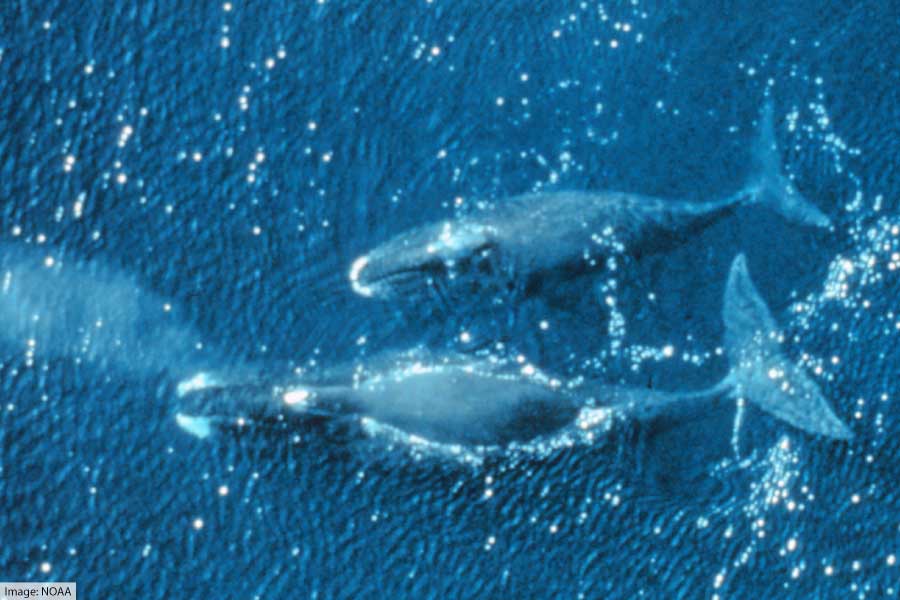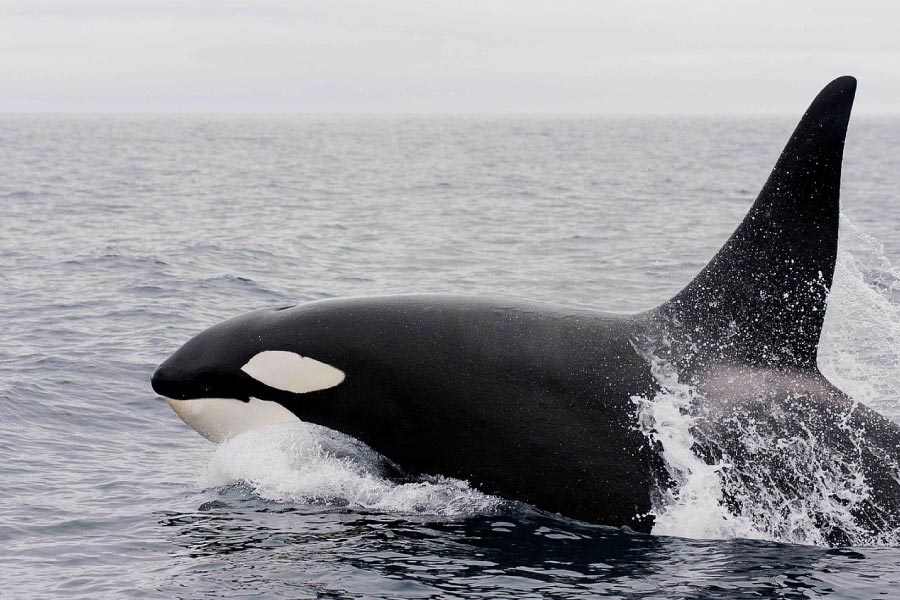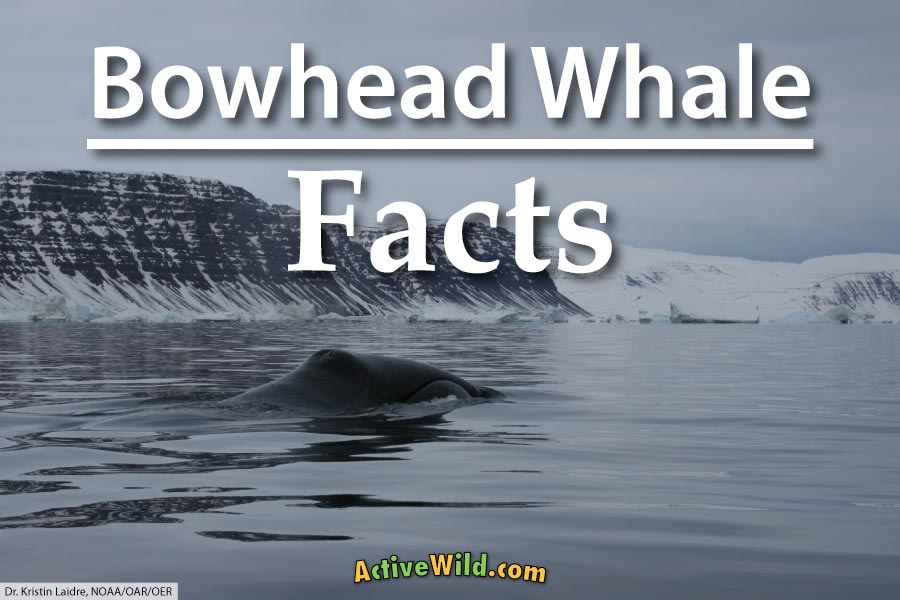With a lifespan of over 200 years, the bowhead whale is thought to be the world’s longest living mammal. It’s also one of the largest living animals, and the animal with the largest mouth.
Continue reading to find out more about this fascinating species...
Page Index
- Bowhead Whale Facts At A Glance
- Meet The Bowhead Whale: Introduction
- What Does The Bowhead Whale Look Like?
- Where Does The Bowhead Whale Live?
- Habitat
- Behavior
- Communication
- How Fast Can A Bowhead Whale Swim?
- Bowhead Whale Life-Cycle
- What Do Bowhead Whales Eat?
- Bowhead Whale Predators
- Is The Bowhead Whale Endangered?
- Bowhead Whale Facts: Discover More With Active Wild
Other relevant pages:
- Pictures and facts on every species of whale: Types of Whales
- Pictures and facts on every species of dolphin: Types of Dolphins
Bowhead Whale Facts At A Glance

- Scientific name: Balaena mysticetus
- Type of Animal: Mammal
- Animal Family: Balaenidae
- Where Found: Arctic Ocean and associated seas
- Length: 14 to 18 m (46 to 59 ft.)
- Weight: 75,000 to 100,000 kg (83 to 110 short tons)
- Conservation Status: Least Concern
Bowhead Whale Fun Facts
- The bowhead whale has the largest mouth of any animal.
- With a lifespan of over 200 years, the bowhead whale may be the longest-lived of all animals
- The bowhead whale and the right whales were once thought to be the same species. (Today, the bowhead whale, North Atlantic right whale, North Pacific right whale and southern right whale are considered separate species.)
- With a length of 4m / 13.12 ft, the baleen plates of the bowhead whale are the longest of any whale.
- The bowhead whale eats around 1,800 kg / 3,968.32 lb of food every day.
- The bowhead whale is a carnivore. Despite the whale's great size, its prey consists of small marine animals, mainly crustaceans such as krill and copepods.
Meet The Bowhead Whale: Introduction
The bowhead whale is a large marine mammal found in Arctic and Subarctic waters. Like all whales, it is a member of Cetacea, the animal group that also contains dolphins and porpoises.
With a maximum weight of around 100 (metric) tonnes (that's 220,462 pounds!) the bowhead whale is one of the heaviest species of whale in the world. It vies for the title of ‘second-largest living whale’ with the similarly-sized right whales, and the longer – but slimmer fin whale.
The bowhead whale is a ‘baleen whale’. Despite their large size, baleen whales feed on small animals and plankton. Their upper jaws are equipped with comb-like structures called baleen plates. These act like giant sieves, filtering the whales’ food from the seawater.
The bowhead whale is the only baleen whale to live exclusively in Arctic and sub-Arctic waters.
What Does The Bowhead Whale Look Like?

The bowhead whale has wide, bulky body and a large head. It is almost entirely black. Contrasting white markings can be seen on its lower jaw. Unlike most whales, the species lacks a dorsal (back) fin. Its pectoral (side) fins are relatively small.
The bowhead whale’s layer of blubber is the thickest of any animal. This insulating layer of fat can be up to 50 cm (20 in) thick.

The head of the bowhead whale has a distinct triangular shape. The length of the skull makes up almost a third of the animal’s total length. There are two blowholes on top of the whale’s head.

The bowhead whale’s huge mouth is the largest of any animal. Its lower jaw has a very pronounced bow-shape, which gives the species its name.
There are around 300 baleen plates on either side of the upper jaw. Each plate is around 3 to 4.5 m (9.8 to 14.8 ft.) in length.
Female bowheads tend to be larger in size than males.
Where Does The Bowhead Whale Live?

The bowhead whale is found in the Arctic Ocean and its associated seas. The species occurs primarily between the latitudes of 60° and 75° north.
Habitat
The bowhead whale is adapted to living in cold waters with seasonal ice coverage. During winter the whale swims in waters near or under the sea ice, while in summer the whale spends more time in open waters and may also be found in estuaries, bays and straits.
The species typically swims at depths of around 100 m (330 ft.), but is able to reach depths of 150 m (500 ft.).
Behavior

The bowhead whale may either be seen traveling alone or in small pods. It typically comes to the surface to breathe after spending 9 to 18 minutes underwater, although dives can last for as long as an hour.
When swimming under ice, the bowhead whale is able to create breathing holes by pushing through ice up to 7 inches thick with its massive head.
The species undergoes seasonal migrations. Its migration patterns are mostly determined by the shifting ice cover and the concentration of prey.
Communication
Bowhead whales use a wide range of calls to communicate. During a 4-year observation period, one population of about 300 animals produced 184 distinct songs.
The whale’s low-frequency vocalizations are capable of traveling large distances through the water, enabling long-range communication between individuals.
Calls are especially intense during migrations, while during the mating season songs tend to be long and highly complex. The whales may also use the echoes of their calls to locate food and navigate.
How Fast Can A Bowhead Whale Swim?

The bowhead whale is a relatively slow swimmer. Its average speed is 2 to 5 km/h (1.2 to 3.1 mph), and its top speed is around 10 km/h (6.2 mph).
Bowhead Whale Life-Cycle
Mating can take place throughout the year, but there is a peak in mating activity during late winter and spring. The male whale’s mating songs are at their peak in March.
The whale’s gestation period lasts about 13 to 14 months, with most calves being born during the spring migration (between April and early June).
A newborn bowhead whale is 4 to 4.5 m (13 to 15 ft.) in length and weighs about 1,000 kg (2,200 lb.). It is born with a thick layer of blubber and is able to swim independently almost immediately after being born.
A close bond forms between a mother and her calf. Weaning takes place at between 9 and 12 months of age.
A female bowhead will typically give birth every 3 to 7 years. Young whales are thought to reach sexual maturity between the ages 18 and 33.
Diet: What Do Bowhead Whales Eat?

Like all baleen whales, the bowhead whale is a filter feeder. Its diet consists mainly of marine zooplankton. This includes small to medium-sized crustaceans, such as krill, copepods, and amphipods. The whale may also ingest other small invertebrates and fish.
When feeding, the bowhead whale swims with its mouth wide open. Large volumes of water are pushed through the overlapping baleen plates, trapping food inside the whale’s mouth.
The bowhead whale may consume roughly 100 metric tons (over 220,000 lb.) of crustaceans each year. Most of the feeding takes place when the whales are in their winter feeding grounds. During the winter months, the whales often feed near the bottom, while during summer and fall they spend more time feeding near the surface and in mid-water.
The bowhead whale will either forage alone or in groups of up to 14 individuals.
Bowhead Whale Predators

Killer whales are known predators of bowhead whales. When threatened, bowheads seek the safety of shallow waters or ice.
Is The Bowhead Whale Endangered?
The bowhead whale is rated ‘Least Concern’ by the International Union for Conservation of Nature (website), and its population is thought to be increasing.
Two bowhead whale subpopulations – those that inhabit the East Greenland-Svalbard-Barents Sea and the Okhotsk Sea – have been separately assessed by the IUCN and are rated ‘Endangered’.
The species’ global population is thought to exceed 25,000 individuals, although there are only a few hundred animals in the two smallest subpopulations.
Commercial hunting of bowhead whales was banned in the 1930s and is no longer a threat. The impact of other threats like entanglement in fishing gear, vessel strikes, oil and gas exploration, noise pollution, accumulation of contaminants, reduction of sea ice and rising sea temperatures on bowhead whale populations is currently unclear.
Bowhead Whale Facts: Discover More With Active Wild
- Arctic Animals List with Pictures & Facts
- See a list of every living species of whale on this page: Types of Whales Pictures & Facts
- Blue Whale Facts
- Killer Whale Facts
- Fin Whale Facts
- Bottlenose Dolphin Facts
- Mammals: The Ultimate Guide
- Animals: The Ultimate Guide
- Animals A to Z


